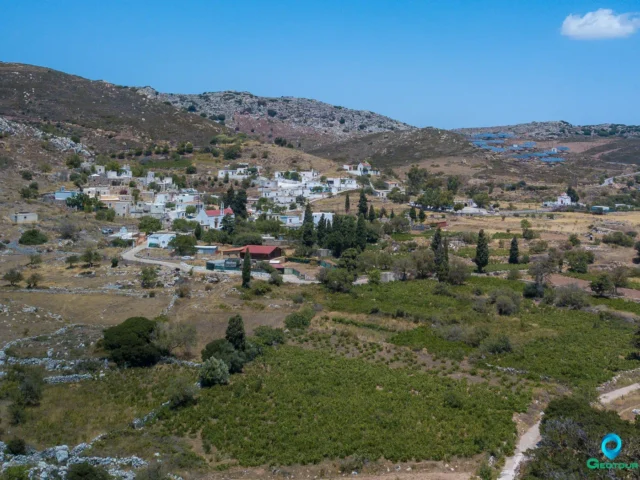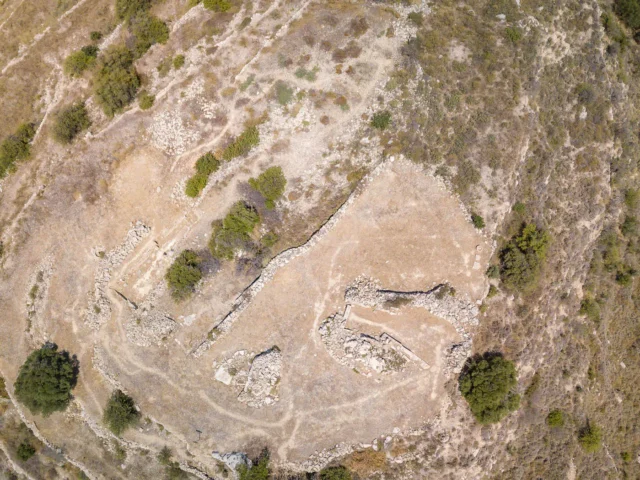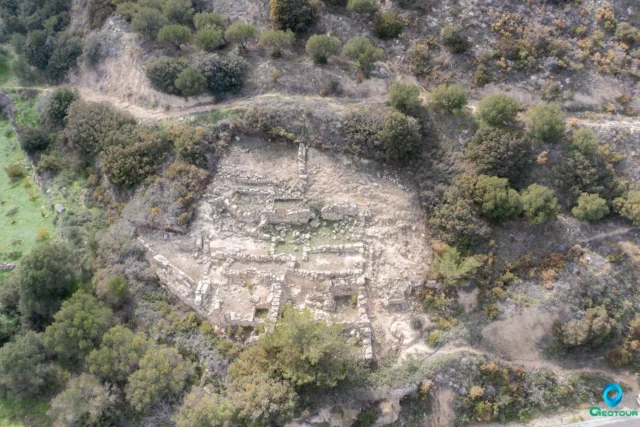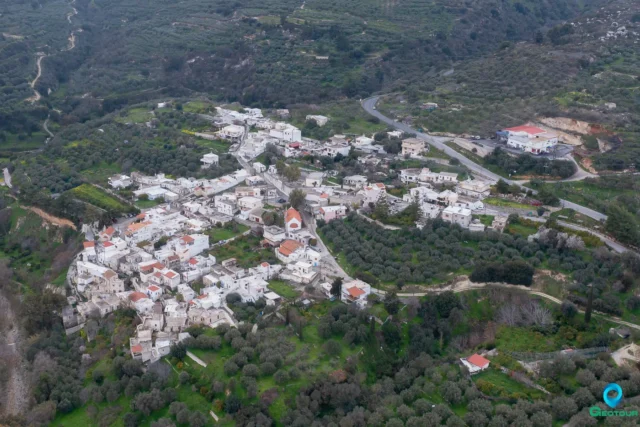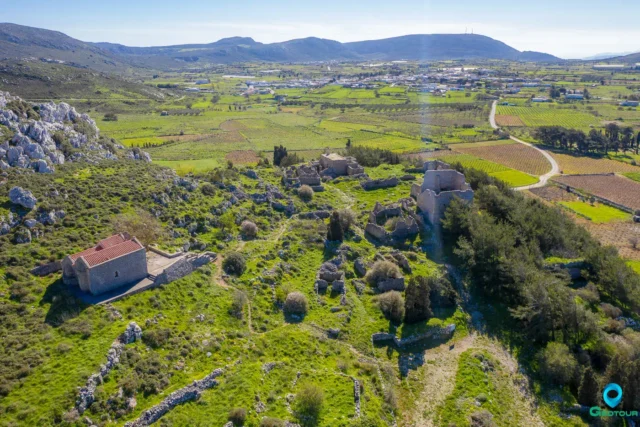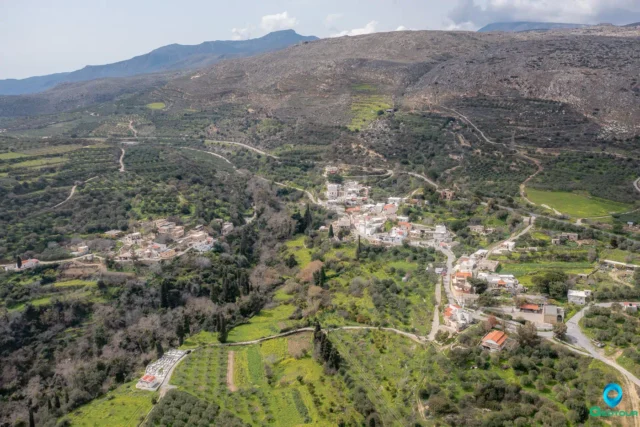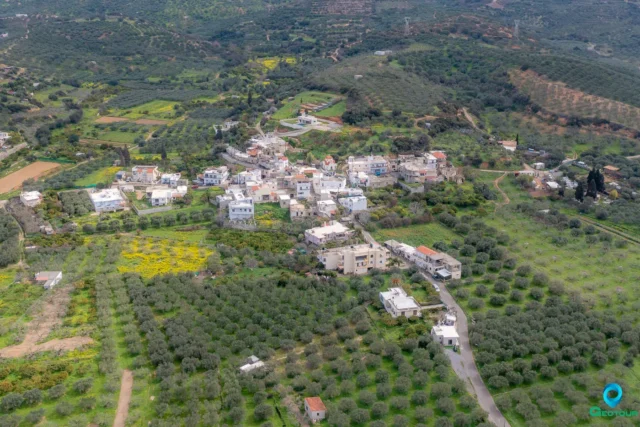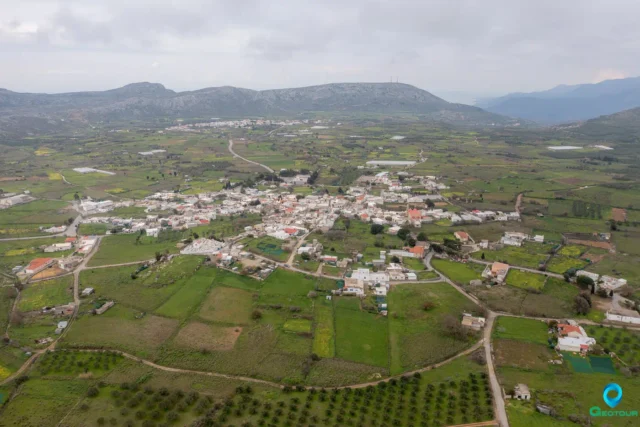Katsidoni (Κατσιδόνι) is a village and the seat of the homonymous community in the municipality of Sitia, in the regional unit of Lasithi, Crete. It is built at an altitude of 560 meters, 15 kilometers south of Sitia.
Name
The name of the village is often encountered with two spellings: Katsidoni (Κατσιδόνι) and Katsidoni (Κατσιδώνι). The correct spelling is with an omicron (ο) and not omega (ω). This is supported by two prominent historians and Cretologists, Stefanos Xanthoudidis and Stergios Spanakis. According to Xanthoudidis, the name of the village comes from the Byzantine family name Katsidonis (ΚΑΤΣΙΔΟΝΗΣ), which was probably the first settler of the village. Spanakis follows Xanthoudidis’ interpretation. Until 1940, the village was written with an omicron. In 1940, the omega appeared in the spelling of the name, but this was an arbitrary renaming contrary to the existing historical reality.
History
On the neighboring mountain of Prinias (803 m), in one of its peaks that rises directly above the Metochia of Piskokefalos, a peak sanctuary was found. It was identified in 1967 but investigated in 1971. Despite its great looting, it seems to have been one of the most important sanctuaries of Eastern Crete. This is evidenced by its findings, which are very important. Among other things, clay models of the insect Rhinoceros Oryctes, a type of beetle, were found. In the area of Katsidoni, there are caves, the most important of which are Yeros Spilios and Kato Platyvolo.
Social life
In August, the inhabitants celebrate the Afentis Christos (August 6) with the organization of a festival. The date is adjusted accordingly to fall on a Saturday. The Katsidoni Cultural Association is also active in the village, which has a page on Facebook, thus giving the opportunity to those who are members (residents of the village or residents in other cities) to be informed about its actions and about events concerning the village.
Traditional settlement
After a request from the Municipality of Sitia, the Region of Crete (May 2022) gave the “green light” for the designation of the settlements of Katsidoni, Sitanos, Karidi, Magasas as protected, thus enhancing their promotion and protection. The purpose of the project is to preserve and highlight their special historical, urban planning, architectural, social and aesthetic physiognomy and their integration into a framework of protection. The Municipality issued a Proclamation of a Public Electronic Open Tender for the selection of a contractor for the service entitled: “Registration of the urban planning and architectural physiognomy of four (4) remarkable settlements of the Municipality of Sitia”.
Tourism – Visitor areas
The Sitia Geopark is located in the easternmost part of Crete and was included in the Network of Global Geoparks of UNESCO in 2015. It covers a very large area, with a total area of 516.7 square kilometers, which covers almost the entire current Municipality of Sitia. Within the Sitia Geopark, 80 sites of geological interest have been identified and mapped, the so-called Geotopes, which the visitor to the Geopark can see during his tour and learn about the geological evolution and geological phenomena of the area. In addition, the Geopark has important Environmental and Cultural heritage with numerous sites, also accessible to visitors. The tour can also be done through the dense network of Geodroms proposed by the Geopark, which includes road, cycling and hiking routes, while a variety of other activities can hold and win the interest of the visitor. One route, number 22, is proposed for cycling and includes Katsidoni (Epano Episkopi – Agios Spyridonas – Ancient Priassos – Katsidoni – Agios Ioannis – Karidi). A part of it can also be done by hiking as suggested and is Katsidoni – Agios Ioannis – Karidi.
Historical data
At the top of Mount Prinias, the remains of a peak sanctuary are preserved, one of the largest in Eastern Crete. Ancient tombs and pottery of various eras have been found in the village. Stefanos Xanthoudidis reports that the name of the village comes from the name of the first settler, the Byzantine surname Katsidonis. The village is mentioned by Francesco Barozzi in 1577 as Cacidoni in the province of Sitia. In the Venetian census of 1583 by Castrofylakas, it is mentioned as Cazzidoni with 218 inhabitants. Vasilicata mentions it in 1630 as Cacidoni. In the Turkish census of 1671, it is mentioned as Kaçidoni with 25 haratsa. The village is mentioned in the Egyptian census of 1834 as Katsidhoni with 10 Christian families. In 1881, it is mentioned as Katsidoni with 143 inhabitants, all Christians, and belonged to the municipality of Karidi.
The village fountain
This village in mountainous Sitia offers coolness and enjoyment. At the entrance of the village, on the main road, there is a renovated fountain that has water throughout the year. The description of the fountain was given by the archaeologist N. Papadakis in a book dedicated to the fountains of the wider area.
Village about 16 km from Sitia on the road to Karidi via Piskokefalos-Stavromenos. In the census of the Venetians of 1853, Cazzidoni is reported to have 213 inhabitants. The Community Department of Katsidoni (also written as Katsidoni) also includes the settlement of Sandali, which, although almost abandoned today, was registered in 1583 with the exact same name (Sandali) with 371 inhabitants. In the neighboring mountain of Prinias (803 m), in one of its peaks that rises directly above the Metochia of Piskokefalos, a peak sanctuary was found. It was identified in 1967 but investigated in 1971. Despite its great looting, it seems to have been one of the most important sanctuaries of Eastern Crete. This is evidenced by its findings, which are very important. Among other things, clay models of the insect Rhinoceros Oryctes, a type of beetle, were found. From Katsidoni came the important scholar and professor of Folklore at the University of Athens, G. Spyridakis. In the area of Katsidoni, there are caves, the most important of which are Yeros Spilios and Kato Platyvolo. The etymology of the name of the village is unknown. from the book by N. Papadakis, archaeologist: SITIA.
Settlement: Key Points
-
Historical References: The village name comes from the Byzantine family name Katsidonis. The correct spelling is Katsidoni (Κατσιδόνι) with an omicron (ο) and not omega (ω).
-
Location: Katsidoni is located in the municipality of Sitia, in the regional unit of Lasithi, Crete. It is built at an altitude of 560 meters, 15 kilometers south of Sitia.
-
Historical Significance: The village is mentioned in various historical sources, including Venetian censuses and Turkish and Egyptian records. It has a rich history dating back to the Byzantine era.
-
Population Data:
YearPopulationNotes1583218as Cazzidoni1881143143 Christians, 0 Muslims1900191192026119281751940151195114619611191971871981661991172200157201154202168 -
Current Status: Katsidoni is a traditional settlement in Crete that has been designated as protected. It is a popular tourist destination, known for its natural beauty and historical significance.
References






